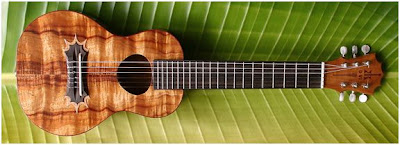 Hawaii's Little Musical Giant
Hawaii's Little Musical GiantHawaii is one of the most beautiful places on planet earth and her culture has spawned some of the most enduring music and musical styles known in the world today. The Hawaiian people are credited with three significant contributions to string music history; slack-key guitar, steel guitar and the Ukulele. Of the three, the ukulele, because of its unique musical voice and diminutive size, was thought to be more of an oddity than a serious musical instrument with mainland musicians. But with Hawaiian musicians, the ukulele has been anything but an oddity.
A Portuguese immigrant was credited with bringing the predecessor of the ukulele to Hawaii in 1879. The 'braguinha' was quickly accepted into Hawaiian music and was dubbed the taro-patch fiddle. The first Hawaiian name for the ukulele was pila li'ili'i which translates as "Little Fiddle." There are numerous accounts as to how this little stringed instrument became known as the ukulele. Ukulele in Hawaiian means "Jumping Flea" but the most plausible explanation is the name evolved from the only indigenous Hawaiian stringed instrument, the ukeke. The ukeke is an ancient mouth-bow instrument with a playing technique similar to the jaw harp. However the ukulele came by its name, the instrument was here to stay and would have an influence on the world music scene.
In 1915, the Hawaiian exhibit at the Panama-Pacific Exposition in San Francisco formally introduced the ukulele to the world. The Royal Hawaiian Quartet, a band that featured guitar, steel guitar, mandolin and the ukulele, played to an estimated 17 million people in a seven-month period. The Hawaiian exhibit was touted as one of the most popular at the exposition and the music was a tremendous success, launching the interest in Hawaiian music in the United States that lasted through World War 11. Hawaiian records were so popular in 1916, that they outsold all other forms of music on the mainland.
The Roaring Twenties brought such a demand for the ukulele that manufacturers couldn't keep up. Because it was inexpensive, small and easier to play than its other stringed counter-parts, it became very popular with people who wanted to play the music and songs of the day, but didn't want to spend the time it takes to learn to play other stringed instruments. Teenagers and college students adopted the uke as their own and it became part of their image as much as straw hats, raccoon coats and striped blazers.
The great depression came and the ukuleles popularity began to fade as the pop songs of the 20's had little meaning to people that were out of work and facing hard times. The ukulele languished through the 1930's and 40's on the mainland, but was forever to be part of the Hawaiian musical culture. The 50's brought a revival to the ukulele and a large part of that revival is credited to Arthur Godfrey. The radio star was now a star of the new medium, television. As an emcee that introduced various acts, Mr. Godfrey would play tunes on his ukulele between acts. As he grew into a bigger star, so did the ukulele, achieving its highest profile ever. Then came rock and roll and the ukulele was put back into the closet until 1968 when Tiny Tim brought it back into the limelight. Some of the more famous Hawaiian musicians and entertainers, along with the not so famous, have kept the little stringed instrument as an integral part of the Hawaiian music culture.
Eddie Karnae, along with his friend, famed slack-key guitarist, Gabby Pahinui, formed the group "Sons of Hawaii" in the 60's and the sounds they created were modern but they had a strong traditional flavor and their music became more and more an identity of Hawaiian music.
Today the ukulele is used in many modern styles and blends of Reggae, Rock and Traditional Hawaiian music, used both as a rhythm and as a lead instrument. With this new popularity, the ukulele has had many new innovations to the instrument itself. Along with the standard four-string soprano concert, tenor and baritone ukes, there are now six-, seven-, eight- and nine-string instruments being made. But one thing is for sure, the tiny little stringed instrument, that has endured the musical roller coaster, is finally getting the respect that it deserves and is here to stay, but of course, a 100 years after its introduction to Hawaii, any Hawaiian musician could have told you that.
2 comments:
Cool Cee...
Here is the Brits ukuing... :)
http://www.youtube.com/watch?v=V3gp7B8WC4Q
Morning Cate! Up so early.WOW! Ur my #1 fan indeed!...lol..:)
Tnx 4 the link. I enjoyed..:);)
Post a Comment